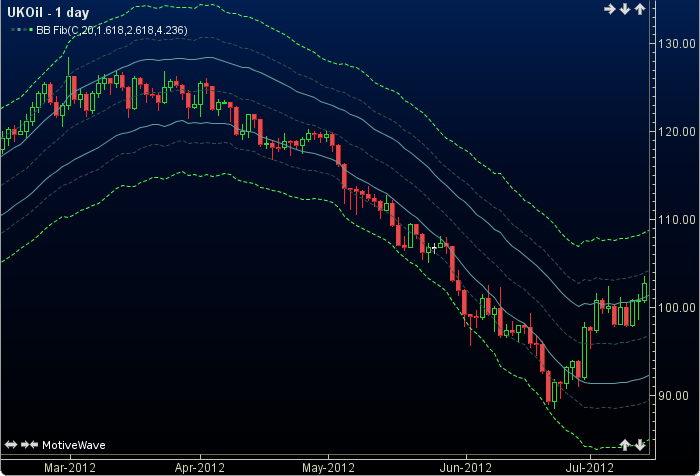Bollinger Bands Fibonacci Ratios
Bollinger Bands® Fibonacci Ratios are based on the same principles as the standard Bollinger Bands®. The base line is a simple moving average. Bands are calculated using Welles Wilders smoothed average true range (ATR). Each band is a fibonacci ratio of the ATR away from the base line. The user may change the input (close), period length and fibonacci ratios. This indicator’s definition is further expressed in the condensed code given in the calculation below.
See also Fibonacci Number.

How To Trade Using Bollinger Bands® Fib Ratios
No trading signals are calculated for this indicator.
How To Access in MotiveWave
Go to the top menu, choose Study>Overlays>Bollinger Bands® Fib Ratios
or go to the top menu, choose Add Study, start typing in this study name until you see it appear in the list, click on the study name, click OK.
Important Disclaimer: The information provided on this page is strictly for informational purposes and is not to be construed as advice or solicitation to buy or sell any security. Please see our Risk Disclosure and Performance Disclaimer Statement.
Calculation
//input = price, user defined, default is close
//period = user defined, default is 20
//fibRatio1 = fibonacci ratio1, default is 1.618
//fibRatio2 = fibonacci ratio2, default is 2.618
//fibRatio3 = fibonacci ratio3, default is 4.236
//smma = smoothed simple moving average
//sma = simple moving average
//index = current bar number
TR = getTrueRange(index) ATR = smma(index, period, TR); sma = sma(index, period, input); r1 = ATR*fibRatio1; r2 = ATR*fibRatio2; r3 = ATR*fibRatio3; Plot1: fibTop3 = sma + r3; Plot2: fibTop2 = sma + r2; Plot3: fibTop3 = sma + r1; Plot4: middle = sma; Plot5: fibBott1 = sma - r1; Plot6: fibBott2 = sma - r2; Plot7: figBott3 = sma - r3;
